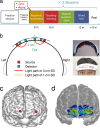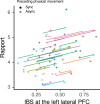Prior physical synchrony enhances rapport and inter-brain synchronization during subsequent educational communication
- PMID: 31484977
- PMCID: PMC6726616
- DOI: 10.1038/s41598-019-49257-z
Prior physical synchrony enhances rapport and inter-brain synchronization during subsequent educational communication
Abstract
Physical synchrony has been suggested to have positive effects on not only concurrent but also subsequent communication, but the underlying neural processes are unclear. Using functional near-infrared spectroscopy (fNIRS) hyperscanning, we tested the effects of preceding physical synchrony on subsequent dyadic teaching-learning communication. Thirty-two pairs of participants performed two experimental sessions. In each session, they underwent a rhythmic arm movement block with synchronous or asynchronous conditions, and then taught/learned unknown words to/from each other according to a given scenario. Neural activities in their medial and left lateral prefrontal cortex (PFC) were measured and inter-brain synchronization (IBS) during the teaching-learning blocks was evaluated. Participants rated their subjective rapport during the teaching-learning blocks, and took a word memory test. The analyses revealed that (1) prior physical synchrony enhanced teacher-learner rapport; (2) prior physical synchrony also enhanced IBS in the lateral PFC; and (3) IBS changes correlated positively with rapport changes. Physical synchrony did however not affect word memory performance. These results suggest that IBS can be useful to measure the effects of social-bonding facilitation activities for educational communication.
Conflict of interest statement
The authors declare no competing interests.
Figures





Similar articles
-
Interplay between prior knowledge and communication mode on teaching effectiveness: Interpersonal neural synchronization as a neural marker.Neuroimage. 2019 Jun;193:93-102. doi: 10.1016/j.neuroimage.2019.03.004. Epub 2019 Mar 7. Neuroimage. 2019. PMID: 30851445 Clinical Trial.
-
When do we fall in neural synchrony with others?Soc Cogn Affect Neurosci. 2019 Mar 5;14(3):253-261. doi: 10.1093/scan/nsz012. Soc Cogn Affect Neurosci. 2019. PMID: 30753646 Free PMC article.
-
Culture, sex and social context influence brain-to-brain synchrony: an fNIRS hyperscanning study.BMC Psychol. 2024 Jun 14;12(1):350. doi: 10.1186/s40359-024-01841-3. BMC Psychol. 2024. PMID: 38877525 Free PMC article.
-
What Guides Us to Neurally and Behaviorally Align With Anyone Specific? A Neurobiological Model Based on fNIRS Hyperscanning Studies.Neuroscientist. 2020 Apr;26(2):108-116. doi: 10.1177/1073858419861912. Epub 2019 Jul 11. Neuroscientist. 2020. PMID: 31296135 Review.
-
What has social neuroscience learned from hyperscanning studies of spoken communication? A systematic review.Neurosci Biobehav Rev. 2022 Jan;132:1249-1262. doi: 10.1016/j.neubiorev.2020.09.008. Epub 2020 Oct 3. Neurosci Biobehav Rev. 2022. PMID: 33022298
Cited by
-
HyperOptoNet: a MATLAB-based toolbox for inter-brain neuronal synchrony analysis using fNIRS hyperscanning.Neurophotonics. 2023 Apr;10(2):025015. doi: 10.1117/1.NPh.10.2.025015. Epub 2023 Jun 13. Neurophotonics. 2023. PMID: 37325778 Free PMC article.
-
Investigating the effect of synchronized movement on toddlers' word learning.Front Psychol. 2022 Nov 24;13:1008404. doi: 10.3389/fpsyg.2022.1008404. eCollection 2022. Front Psychol. 2022. PMID: 36506988 Free PMC article.
-
Affiliative bonding between teachers and students through interpersonal synchronisation in brain activity.Soc Cogn Affect Neurosci. 2020 Jan 30;15(1):97-109. doi: 10.1093/scan/nsaa016. Soc Cogn Affect Neurosci. 2020. PMID: 32022237 Free PMC article.
-
Bringing together multimodal and multilevel approaches to study the emergence of social bonds between children and improve social AI.Front Neuroergon. 2024 May 17;5:1290256. doi: 10.3389/fnrgo.2024.1290256. eCollection 2024. Front Neuroergon. 2024. PMID: 38827377 Free PMC article.
-
The emergence of moral alignment within human groups is facilitated by interbrain synchrony.Commun Biol. 2025 Mar 20;8(1):464. doi: 10.1038/s42003-025-07831-4. Commun Biol. 2025. PMID: 40114031 Free PMC article.
References
-
- Vicaria IM, Dickens L. Meta-analyses of the intra-and interpersonal outcomes of interpersonal coordination. Journal of Nonverbal Behavior. 2016;40:335–361. doi: 10.1007/s10919-016-0238-8. - DOI
-
- Hove MJ, Risen JL. It’s all in the timing: Interpersonal synchrony increases affiliation. Social Cognition. 2009;27:949–960. doi: 10.1521/soco.2009.27.6.949. - DOI
Publication types
MeSH terms
LinkOut - more resources
Full Text Sources
Miscellaneous

